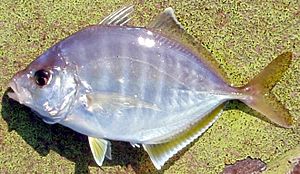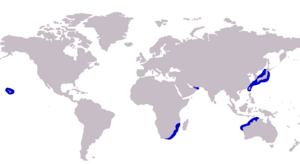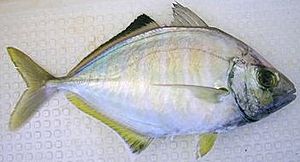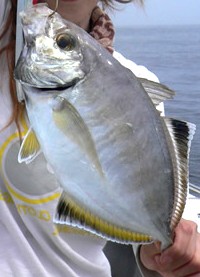Whitefin trevally facts for kids
Quick facts for kids Whitefin trevally |
|
|---|---|
 |
|
| Conservation status | |
| Scientific classification | |
 |
|
| Known range of the whitefin trevally | |
| Synonyms | |
|
The whitefin trevally (Carangoides equula), also known as the horse trevally, is a type of fish found in deep ocean waters. It belongs to the jack family, called Carangidae.
This fish lives in warm and mild waters across the Indo-Pacific and central Pacific Ocean. Its home ranges from South Africa all the way to Hawaii. The whitefin trevally is a medium-sized fish, growing up to 37 centimeters long. It has special features like its fin size, gill count, and unique colors.
It prefers to live on the continental shelf and slope where the ocean floor is sandy or muddy. It can be found at depths of up to 200 meters. The whitefin trevally eats other fish, crustaceans, and cephalopods. In Japan, this fish is very important for fishing. It is caught using trawlers, but fewer are being caught now than in the 1980s. People also enjoy eating it.
Contents
About the Whitefin Trevally
The whitefin trevally is part of a group of fish called Carangoides. These are commonly known as jacks and trevallies. The Carangoides genus is part of the larger jack and horse mackerel family, Carangidae. This family is then part of the order Carangiformes.
This fish was first described by scientists in 1844. Two Dutch naturalists, Coenraad Jacob Temminck and Hermann Schlegel, studied a fish from Japan. They gave it the scientific name Caranx equula. Later, scientists moved it into the Carangoides group. Sometimes, other names were given to this fish, but Carangoides equula is the accepted name today.
What the Whitefin Trevally Looks Like
The whitefin trevally is a fairly small fish. The longest one ever found was about 37.5 centimeters long. Its body is flat from side to side and shaped almost like a diamond. Both its top (dorsal) and bottom (ventral) parts are gently curved.
It has two separate dorsal fins on its back. The first dorsal fin has seven stiff spines. The second one has one spine and 23 to 25 soft rays. This first dorsal fin is quite tall and helps identify the fish. The anal fin on its underside has two separate spines at the front, followed by one spine and 21 to 24 soft rays. Its pelvic fins have one spine and 18 or 19 soft rays.
The lateral line on its side, which helps it sense movement, has a curved part and a straight part. The curved part is longer. The fish's chest is mostly covered in scales. Its mouth has narrow rows of small teeth. It also has 27 to 32 gill rakers and 24 vertebrae (backbones).
The whitefin trevally is silver in color. Its back is blue to green, and its belly is shiny white. The soft dorsal and anal fins are yellowish at the base. The front parts of these fins have dark gray-brown and white bands. Its tail fin is dusky yellow. The pectoral and pelvic fins are white. Young whitefin trevallies have 5 to 7 dark stripes on their sides.
Where the Whitefin Trevally Lives
The whitefin trevally lives in the warm and mild waters of the Indo-Pacific region. However, it's not found everywhere in this area. In the western Indian Ocean, it has only been seen off South Africa, Somalia, and in the Gulf of Oman. In the eastern Indian Ocean, it's known from northwestern Australia and extends into the Pacific Ocean as far as Okinawa.
If the fish called Carangoides dasson is the same as the whitefin trevally, then its range extends even further into the Pacific. This would include Hawaii and Easter Island. Scientists believe the fish might live in more places than we currently know. This is because not all areas have been fully explored.
The whitefin trevally usually lives in deep waters. It prefers the continental shelf and slope at depths of 90 to 200 meters. It likes areas with sandy and muddy bottoms. There is one rare report of this fish being caught near a sandy beach in Japan. However, this was likely a fish that had strayed from its usual deep-water home.
Diet and Reproduction
The whitefin trevally is a predator that lives near the ocean floor. It eats various small fish, crustaceans, and cephalopods. It can find its prey by either searching for it or chasing it down. Its eyes are very good at seeing in the deep, dim waters. Like the white trevally, it has a special reflective layer in its eyes called a tapetum. This helps it see well in low light.
Scientists have studied the whitefin trevally's growth and reproduction in Japan. This is because the fish is important for fishing there. Female fish start to reproduce when they are at least 15.1 centimeters long. Most are ready to spawn when they are about 17.4 centimeters long. All females can reproduce by the time they reach 24 centimeters. Male fish likely follow a similar pattern.
In Japan, whitefin trevallies have a long spawning season. It lasts from May to October. During this time, females lay eggs multiple times. Each time, they can release between 13,862 and 79,899 eggs. Males and females grow at similar rates and have similar lifespans. After their first year, they are about 7.5 centimeters long. By their second year, they reach 12.3 centimeters. After three years, they are about 16.0 centimeters, and after four years, they are around 18.8 centimeters long.
Relationship to Humans
The whitefin trevally is an important fish for commercial fishing in Japan. There, it is known as kaiwari. It is less important for fishing in other parts of its range. For reasons that are not fully understood, the number of whitefin trevallies caught in Japan has dropped by half since the mid-1980s.
This fish is mainly caught by bottom trawls on the continental shelf. It is considered a good fish to eat.
See also
 In Spanish: Carangoides equula para niños
In Spanish: Carangoides equula para niños




